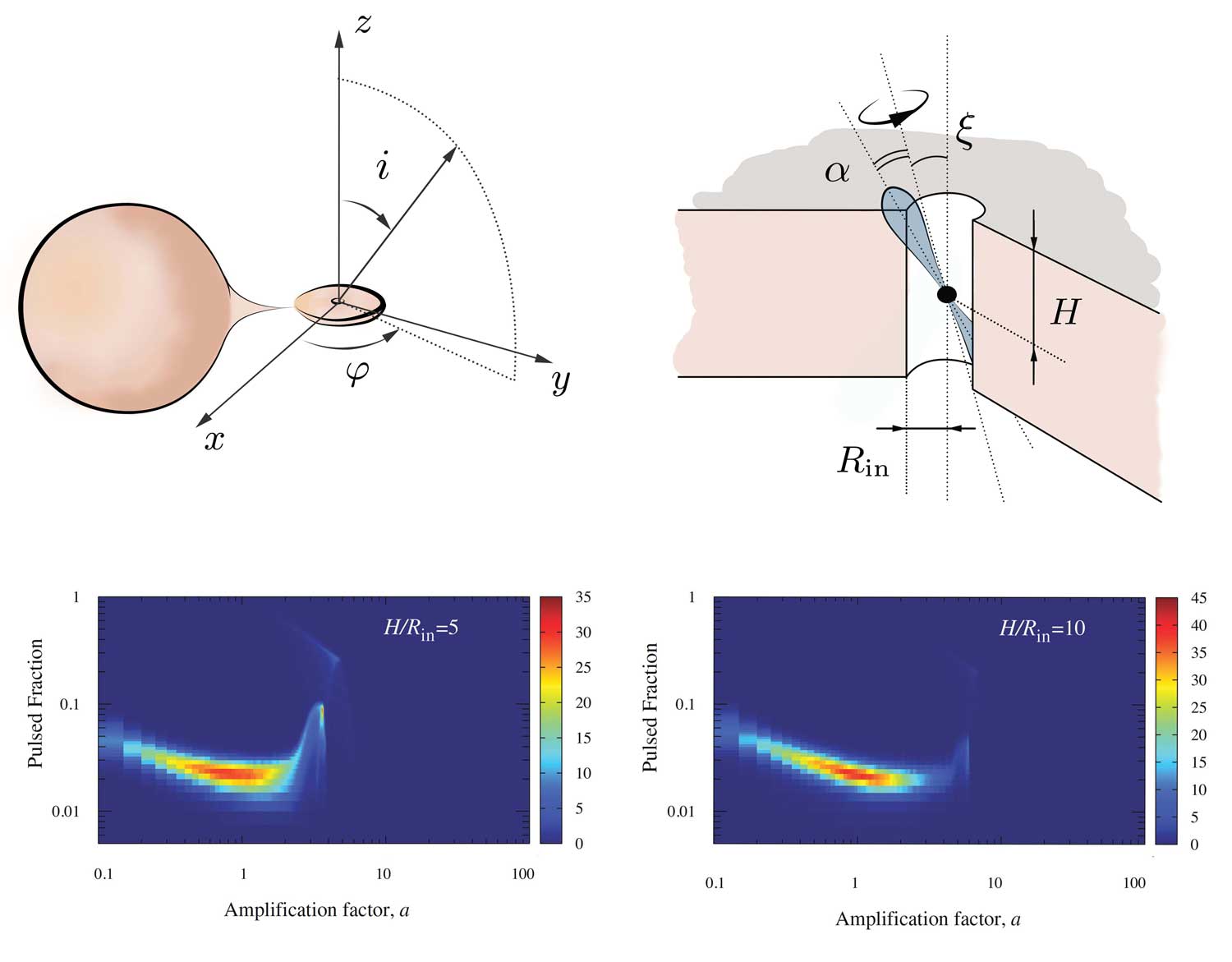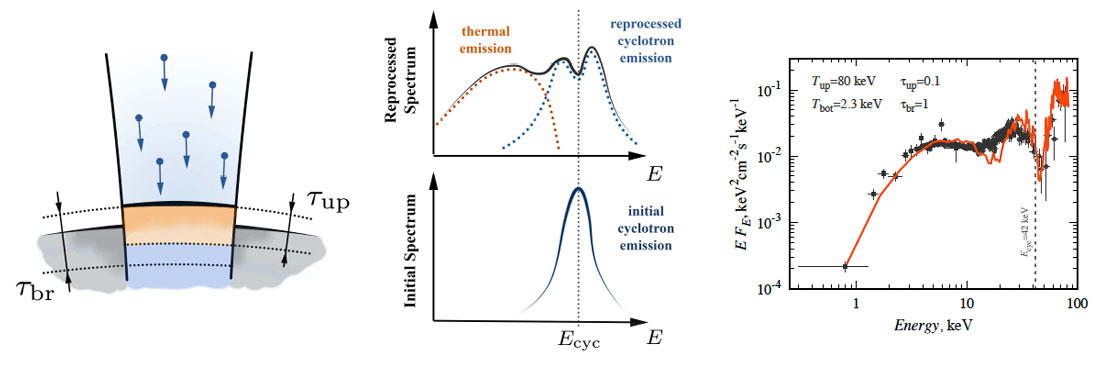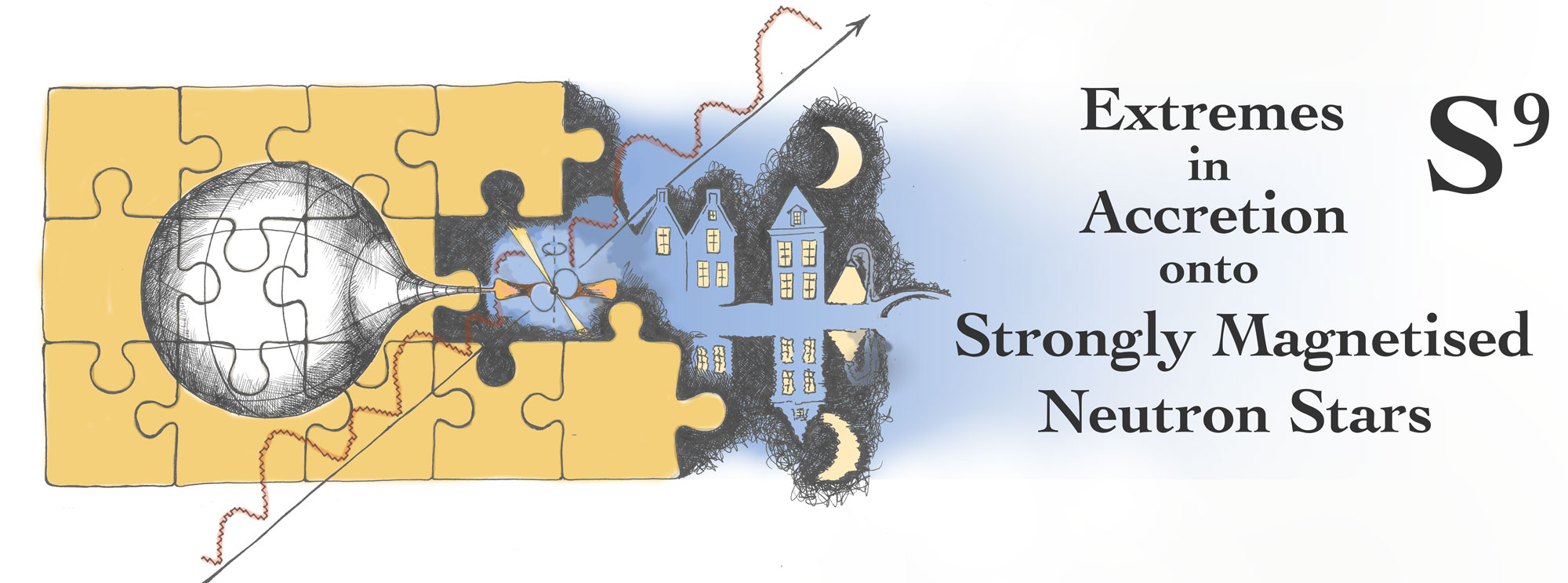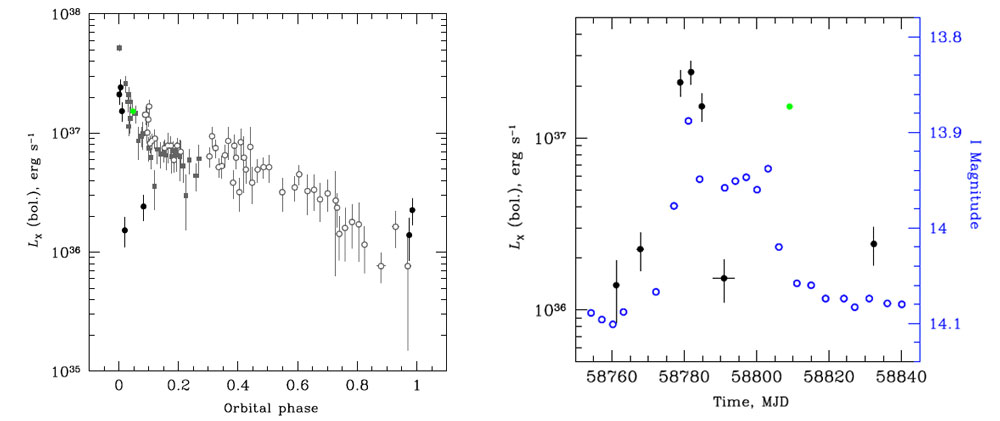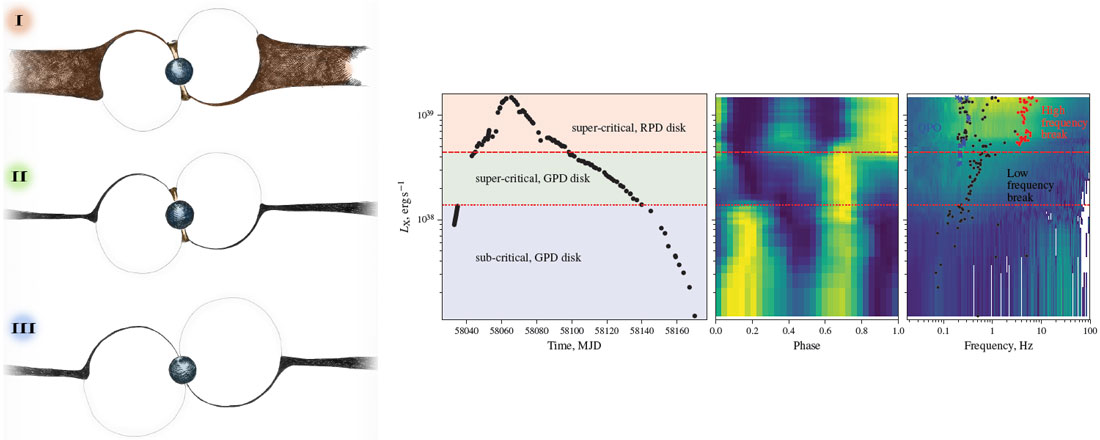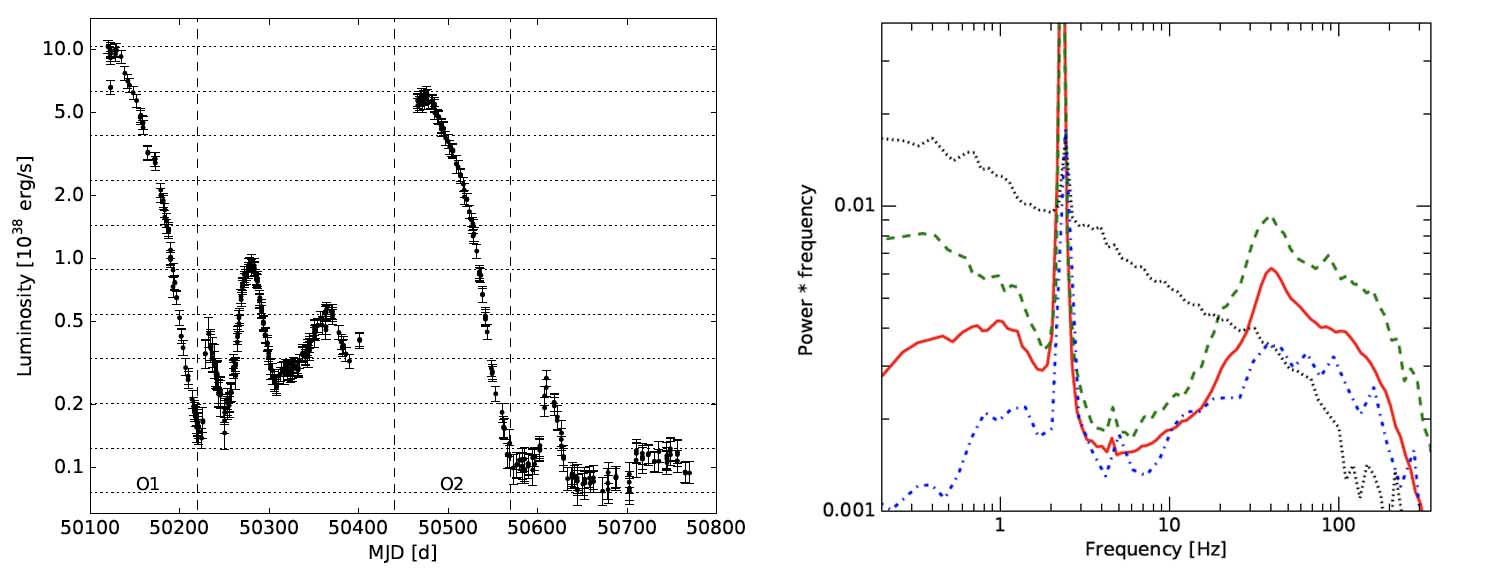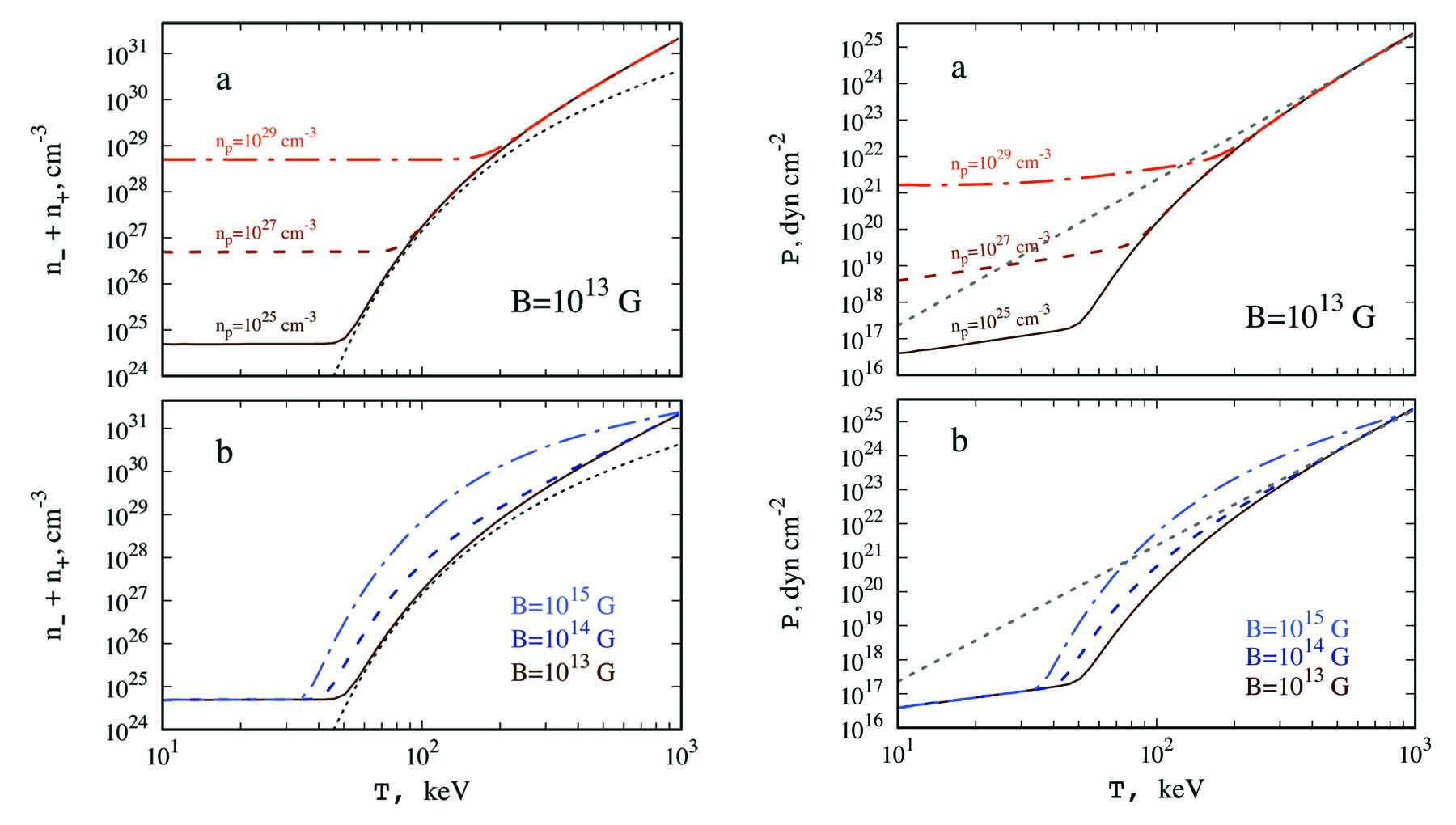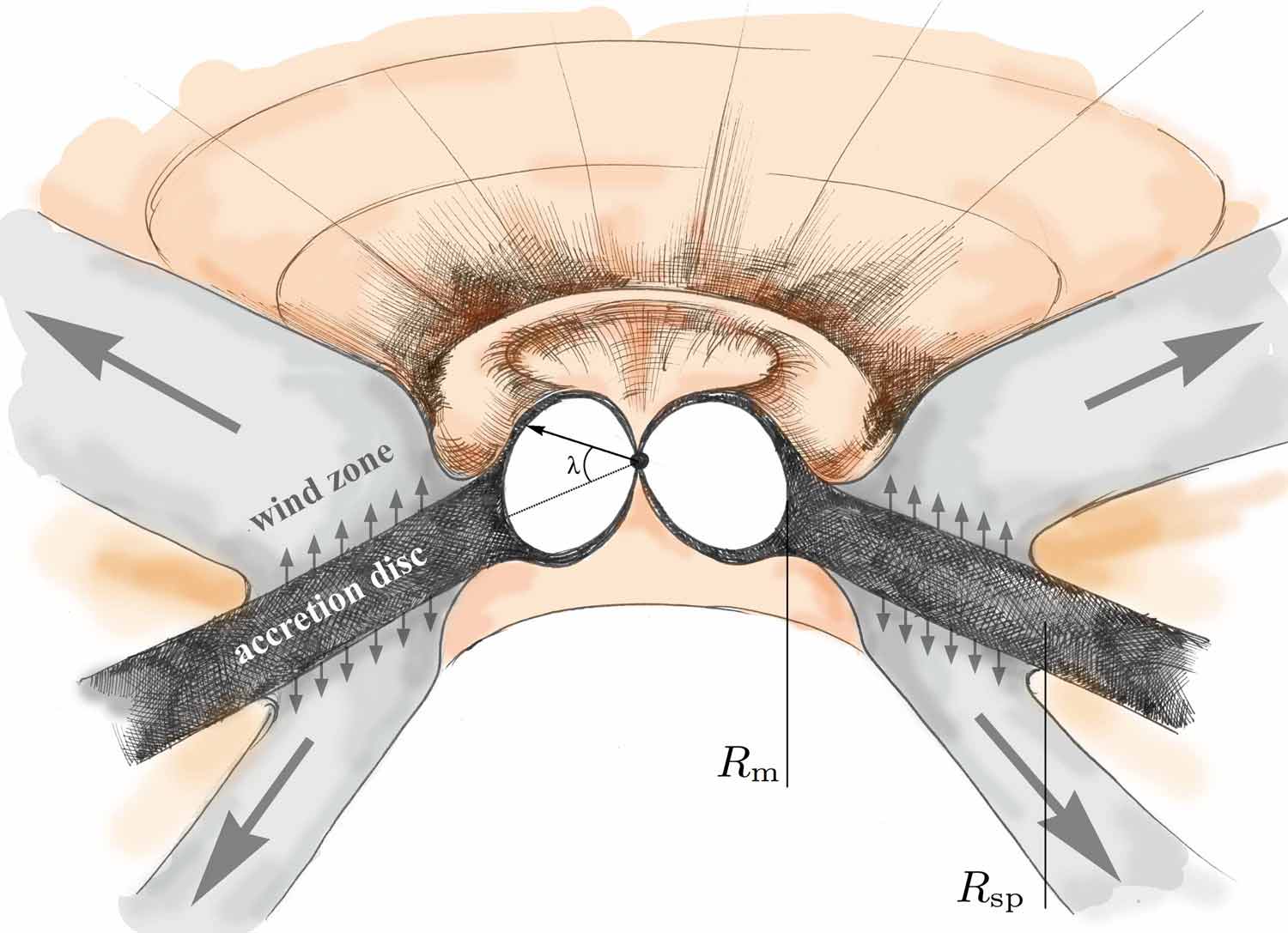
Alexander A. Mushtukov
Astrophysicist at the Uni. of Oxford

News
Pulsating ULXs: large pulsed fraction excludes strong beaming
November, 2020
|
The recent discovery of pulsating ultra-luminous X-ray sources (ULXs) shows that the apparent luminosity of accreting neutron stars can exceed the Eddington luminosity by a factor of hundreds. But how is the apparent luminosity related to the actual one? It is still a question. A typical feature of known pulsating ULXs is a large pulsed fraction. Our new paper shows that the large pulsed fraction and strong amplification of luminosity exclude each other. Therefore, pulsating ULXs are not strongly beamed, and their apparent luminosity is close to the actual one. [see the article] |
Spectrum formation in X-ray pulsars at very low mass accretion rate
June, 2020
|
It has been recently discovered that the transition of X-ray pulsars to the low luminosity state is accompanied by a dramatic spectral changes. Namely, the typical power-law-like spectrum with high energy cutoff transforms into a two-component structure with a possible cyclotron absorption feature on top of it. It was proposed that these spectral characteristics can be explained qualitatively by the emission of cyclotron photons in the atmosphere of the neutron star caused by collisional excitation of electrons to upper Landau levels and further comptonization of the photons by electron gas. The latter is expected to be overheated in a thin top layer of the atmosphere. We perform Monte Carlo simulations of the radiative transfer in the atmosphere of an accreting neutron star while accounting for a resonant scattering of polarized X-ray photons by thermally distributed electrons. The spectral shape is shown to be strongly polarization-dependent in soft X-rays and near the cyclotron scattering feature. The results of our numerical simulations are tested against the observational data of X-ray pulsar A 0535+262. We show that the spectral shape of the pulsar can be reproduced by the proposed theoretical model. The applications of the discovery to the observational studies of accreting neutron stars are discussed. [see the article] |
|
Our symposium will be on the 29-30 of June 2020, and aims to bring together experts (both observers and theoreticians) who focus their research on different aspects of extreme accretion onto strongly magnetized NSs. More information about the Special Session can be found here: info on Symposium 9 |
The unusual behaviour of the young X-ray pulsar SXP 1062
March, 2020
|
In a new paper, Dr. Sergey Tsygankov and co-authors present results of the first dedicated observation of the young X-ray pulsar SXP 1062 in the broad X-ray energy band obtained during its 2019 outburst with the NuSTAR and XMM-Newton observatories. The analysis of the pulse-phase averaged and phase-resolved spectra in the energy band from 0.5 to 70 keV did not reveal any evidence for the presence of a cyclotron line. The spin period of the pulsar was found to have decreased to 979.48+/-0.06 s implying a ~10% reduction compared to the last measured period during the monitoring campaign conducted about five years ago, and is puzzling considering that the system apparently did not show major outbursts ever since. The switch of the pulsar to the spin-up regime supports the common assumption that torques acting on the accreting neutron star are nearly balanced and thus SXP 1062 likely also spins with a period close to the equilibrium value for this system. The current monitoring of the source revealed also a sharp drop of its soft X-ray flux right after the outburst, which is in drastic contrast to the behaviour during the previous outburst when the pulsar remained observable for years with only a minor flux decrease after the end of the outburst. This unexpected off state of the source lasted for at most 20 days after which SXP 1062 returned to the level observed during previous campaigns. [see the article] |
Hot disk of the Swift J0243.6+6124
October, 2019
|
Dr. Victor Doroshenko reports on analysis of observations of the bright transient X-ray pulsar Swift J0243.6+6124 obtained during its 2017-2018 giant outburst with Insight-HXMT, NuSTAR, and Swift observatories. We focus on the discovery of a sharp state transition of the timing and spectral properties of the source at super-Eddington accretion rates, which we associate with the transition of the accretion disk to a radiation pressure dominated state, the first ever directly observed for magnetized neutron star. This transition occurs at slightly higher luminosity compared to already reported transition of the source from sub- to super-critical accretion regime associate with onset of an accretion column. We argue that this scenario can only be realized for comparatively weakly magnetized neutron star, not dissimilar to other ultra-luminous X-ray pulsars, which accrete at similar rates. Further evidence for this conclusion is provided by the non-detection of the transition to the propeller state in quiescence which strongly implies compact magnetosphere and thus rules out magnetar-like fields. [see the article] |
Discovery of a Pulse-phase-transient Cyclotron Line
September, 2019
|
We report the discovery of absorption features in the X-ray spectrum of the transient X-ray pulsar GRO J2058+42. The features are detected around 10, 20, and 30 keV in both NuSTAR observations carried out during the source type II outburst in spring 2019. The most intriguing property is that the deficit of photons around these energies is registered only in the narrow phase interval covering around 10% of the pulsar spin period. We interpret these absorption lines as a cyclotron resonant scattering line (fundamental) and two higher harmonics. The measured energy allow us to estimate the magnetic field strength of the neutron star as ∼1.e12 G. [see the article] |
Cyclotron emission, absorption, and the two faces of X-ray pulsar A 0535+262
May, 2019
|
In a new letter to MNRAS, Dr. Sergey Tsygankov reports on deep NuSTAR observation of X-ray pulsar A 0535+262, performed at a very low luminosity of ∼7.e34 erg/s, revealed the presence of two spectral components. We argue that the high-energy component is associated with cyclotron emission from recombination of electrons collisionally excited to the upper Landau levels. The cyclotron line energy of E~48 keV was measured at the luminosity of almost an order of magnitude lower than what was achieved before. The data firmly exclude a positive correlation of the cyclotron energy with the mass accretion rate in this source. [see the article] |
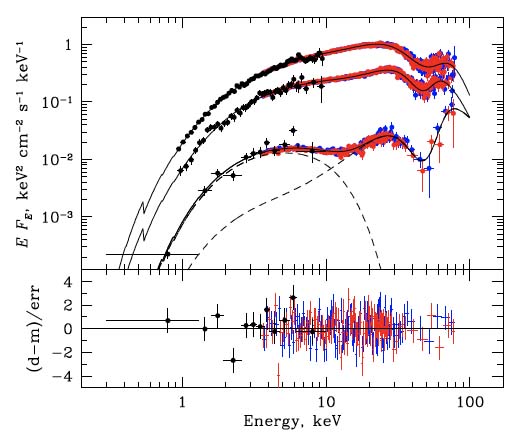 |
Evidence for the radiation-pressure dominated accretion disk in bursting pulsar GRO J1744-28
May, 2019
|
Juhani Mönkkönen reports in his recent paper on the evidence for the radiation-pressure dominated accretion disk in bursting pulsar GRO J1744-28. The conclusions of this paper are based on timing analyses of broadband aperiodic variability of the source. We found that the observed power density spectra of GRO J1744-28 differs dramatically from the canonical shape. We argue that the observational facts can be attributed to the existence of the radiation-pressure dominated region in the accretion disk at luminosities above 2.e37 erg/s and small radius of the magnetosphere, which might be a result of neutron star magnetic field dominated by non-dipole component. [see the article] |
Electron-positron pairs in hot plasma of accretion column in bright X-ray pulsars
April, 2019
|
In our new paper, we discuss the possibility and consequences of intensive pair creation inside accretion columns in bright X-ray pulsars. It is well known that the luminosity of X-ray pulsars powered by accretion onto magnetized neutron stars covers a wide range over a few orders of magnitude. The brightest X-ray pulsars recently discovered as pulsating ultraluminous X-ray sources reach accretion luminosity above 1.e40 erg/s which exceeds the Eddington value more than by a factor of ten. Most of the energy is released within small regions in the vicinity of magnetic poles of an accreting neutron star - in accretion columns. Because of the extreme energy release within a small volume accretion columns of bright X-ray pulsars are ones of the hottest places in the Universe, where the internal temperature can exceed 100 keV. Under these conditions, the processes of creation and annihilation of electron-positron pairs can be influential but have been largely neglected in theoretical models of accretion columns. We investigate properties of a gas of electron-positron pairs under physical conditions typical for accretion columns and argue that the process of pairs creation can crucially influence both the dynamics of the accretion process and internal structure of accretion column limiting its internal temperature, dropping the local Eddington flux and increasing the gas pressure. [see the article] |
Aperiodic variability in X-ray pulsars
April, 2019
|
In our new paper, we investigate aperiodic X-ray flux variability in accreting highly magnetized neutron stars - X-ray pulsars (XRPs). The X-ray variability is largely determined by mass accretion rate fluctuations at the NS surface, which replicate accretion rate fluctuations at the inner radius of the accretion disc.
The variability at the inner radius is due to fluctuations arising all over the disc and propagating inwards under the influence of viscous diffusion.
The inner radius varies with mean mass accretion rate and can be estimated from the known magnetic field strength and accretion luminosity of XRPs.
Observations of transient XRPs covering several orders of magnitude in luminosity give a unique opportunity to study effects arising due to the changes of the inner disc radius.
We investigate the process of viscous diffusion in XRP accretion discs and construct new analytical solutions of the diffusion equation applicable for thin accretion discs truncated both from inside and outside.
Our solutions are the most general ones derived in the approximation of Newtonian mechanics.
We argue that the break observed at high frequencies in the power density spectra of XRPs corresponds to the minimal time scale of the dynamo process, which is responsible for the initial fluctuations.
Comparing data from the bright X-ray transient A 0535+26 with our model, we conclude that the time scale of initial variability in the accretion disc is a few times longer than the local Keplerian time scale. [see the article] |
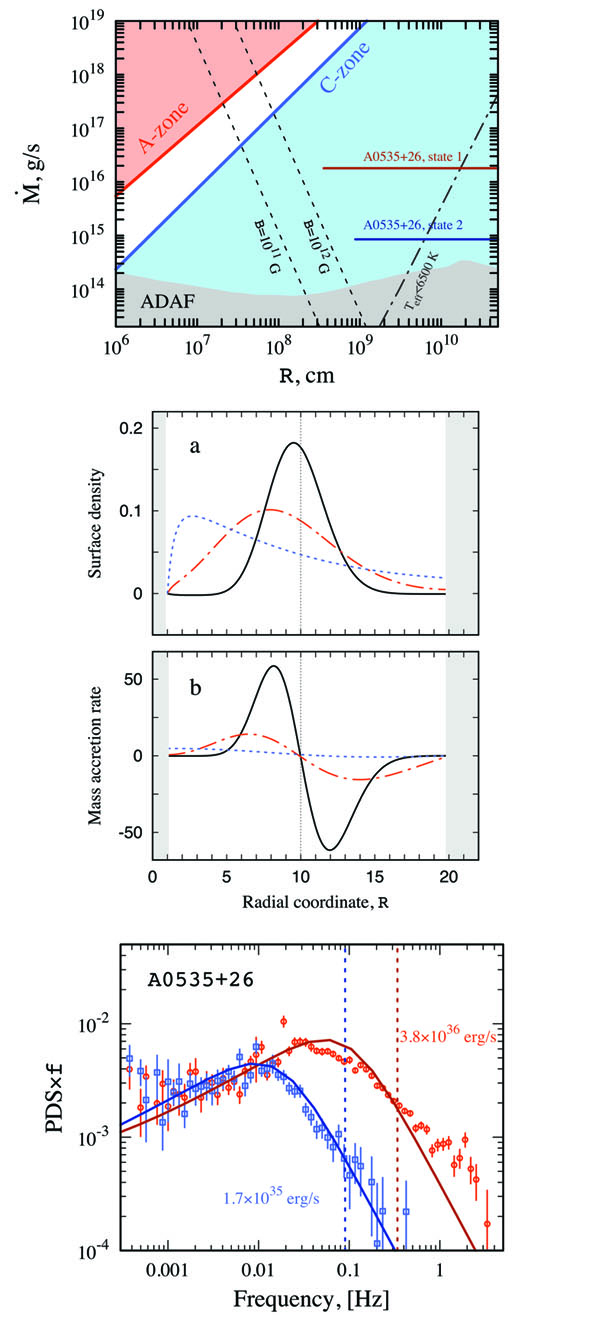 |
Study of the X-ray pulsar IGR J19294+1816 with NuSTAR
January, 2019
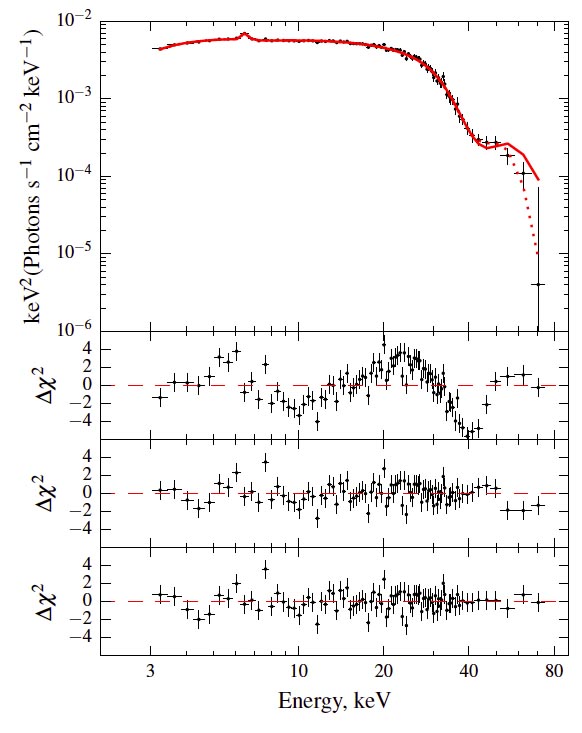 |
In a new paper we present the results of two deep broad-band observations of the poorly studied X-ray pulsar IGR J19294+1816 obtained with the NuSTAR observatory. The source was observed during Type I outburst and in the quiescent state. In the bright state a cyclotron absorption line in the energy spectrum was discovered at 42 keV. Spectral and timing analysis prove the ongoing accretion also during the quiescent state of the source. Based on the long-term flux evolution, particularly on the transition of the source to the bright quiescent state with luminosity around 1.e35 erg/s, we concluded that IGR J19294+1816 switched to the accretion from the "cold" accretion disc (see
the paper on stable accretion from cold discs) between Type I outbursts.
[see the article] |
Timing properties of ULX pulsars affected by optically thick envelopes and outflows from the disc
November, 2018
|
It has recently been discovered that a fraction of ultra-luminous X-ray sources (ULXs) exhibit X-ray pulsations, and are therefore powered by super-Eddington accretion onto magnetized neutron stars (NSs). For typical ULX mass accretion rates, the inner parts of the accretion disc are expected to be in the supercritical regime, meaning that some material is lost in a wind launched from the disc surface, while the rest forms an optically thick envelope around the NS as it follows magnetic field lines from the inner disc radius to the magnetic poles of the star. The envelope hides the central object from a distant observer and defines key observational properties of ULX pulsars: their energy spectrum, polarization, and timing features. The optical thickness of the envelope is affected by the mass losses from the disc. We calculate the mass loss rate due to the wind in ULX pulsars, accounting for the NS magnetic field strength and advection processes in the disc. We argue that the detection of strong outflows from ULX pulsars can be considered evidence of a relatively weak dipole component of the NS magnetic field. We estimate the influence of mass losses on the optical thickness of the envelope and analyze how the envelope affects broadband aperiodic variability in ULXs. We show that brightness fluctuations at high Fourier frequencies can be strongly suppressed by multiple scatterings in the envelope and that the strength of suppression is determined by the mass accretion rate and geometrical size of the magnetosphere. [see the article] |
Dramatic spectral transition of X-ray pulsars in low luminous state
November, 2018
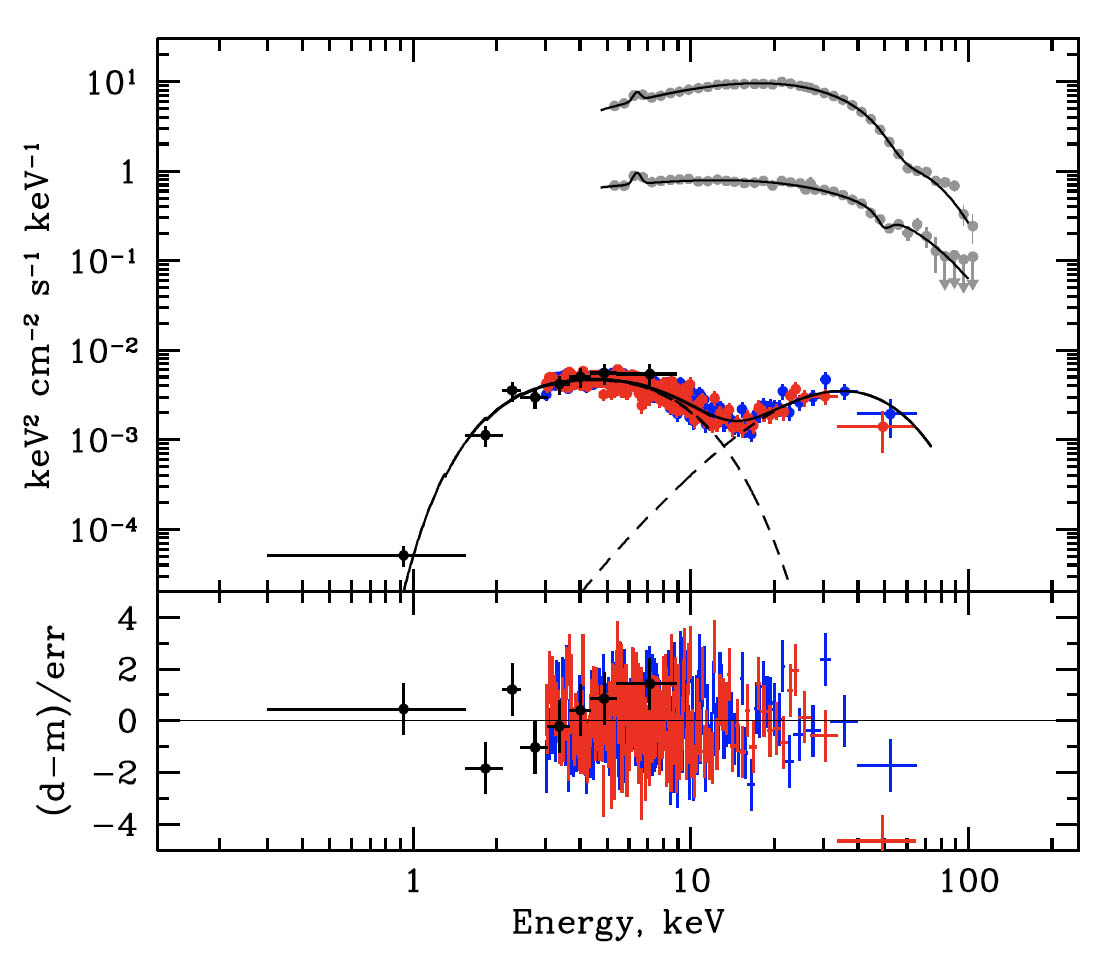 |
We report on the discovery of a dramatic change in the energy spectrum of the X-ray pulsar GX 304-1 appearing at low luminosity. We found that the cutoff power-law spectrum typical for accreting pulsars at higher luminosities of L∼1.e37 erg/s transformed at lower luminosity of L∼1.e34 erg/s to a two-component spectrum peaking around 5 and 40 keV. We suggest that the observed transition corresponds to a change of the dominant mechanism responsible for the deceleration of the accretion flow. We argue that the accretion flow energy at low accretion rates is released in the atmosphere of the neutron star, and the low-energy component in the source spectrum corresponds to the thermal emission of the optically thick, heated atmospheric layers. We suggest that the high-energy component can be associated with thermally broadened cyclotron emission of the upper atmospheric layers overheated to kT∼10−100 keV.
[see the article] |
Discovery of X-rays from the old and faint pulsar
September, 2018
|
Andrei Igoshev reports in his recent paper on the first X-ray observation of the 0.28 s isolated radio pulsar PSR J1154-6250. A point-like source is firmly detected at a position consistent with that of PSR J1154-6250. The two closest stars are outside the 3σ confidence limits of the source position and thus unlikely to be responsible for the observed X-ray emission. The energy spectrum of the source can be fitted equally well either with an absorbed power-law with a steep photon index ~3.3 or with an absorbed blackbody with temperature kT~0.21 keV and emitting radius ~80 m. The X-ray luminosity of 4.4e30 erg/s corresponds to an efficiency of ~4.5e-3, similar to those of other old pulsars. The X-ray properties of PSR J1154-6250 are consistent with an old age and suggest that the spatial coincidence of this pulsar with the OB association Cru OB1 is due to a chance alignment. [see the article] |
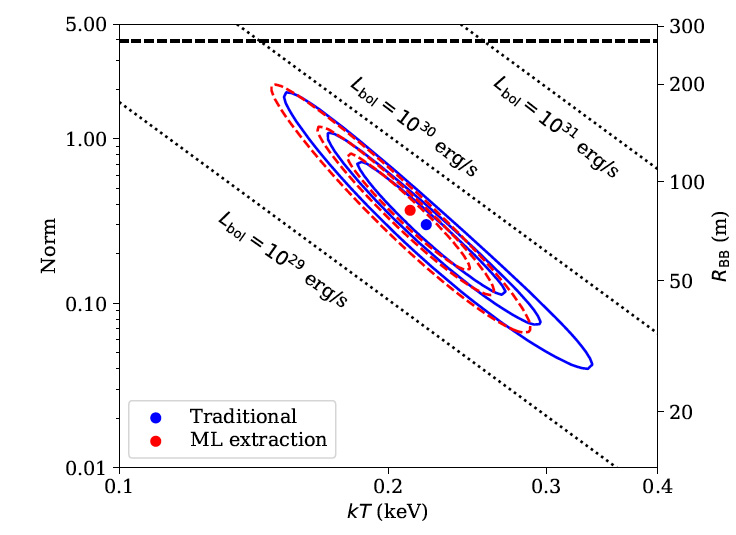 |
On the magnetic field of the first Galactic ultraluminous X-ray pulsar
June, 2018
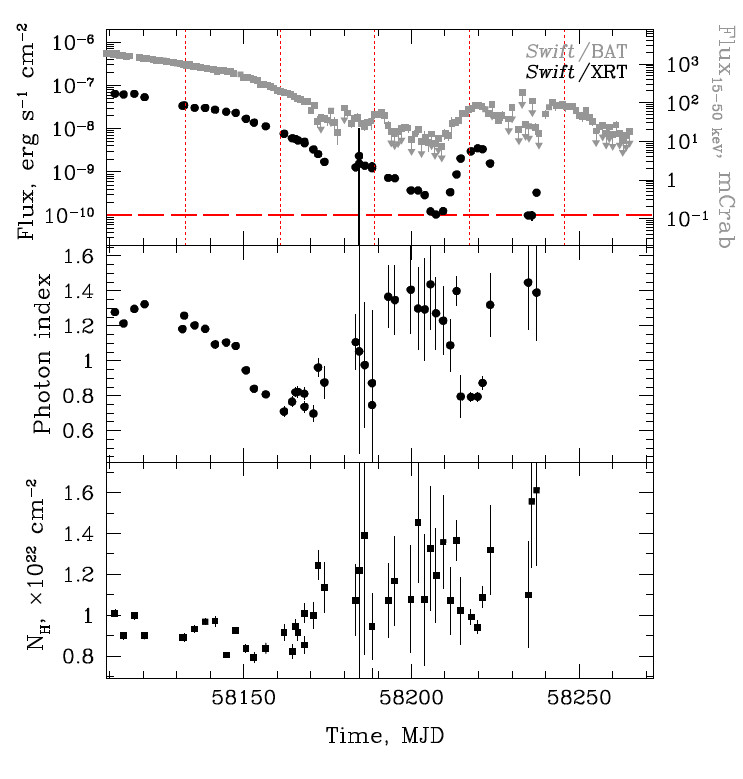 |
We report on the monitoring of the final stage of the outburst from the first Galactic ultraluminous X-ray pulsar Swift J0243.6+6124, which reached ∼40 Eddington luminosities at the peak of the outburst. The main aim of the monitoring program with the Swift/XRT telescope was to measure the magnetic field of the neutron star using the luminosity of transition to the "propeller" state. The visibility constraints, unfortunately, did not permit us to observe the source down to the fluxes low enough to detect such a transition. The tight upper limit on the propeller luminosity < 6.8e35 erg/s implies the dipole component of the magnetic field < 1.e13 G, under plausible assumptions on the effective magnetosphere size. On the other hand, the observed evolution of the pulse profile and of the pulsed fraction with flux points to a change of the emission region geometry at the critical luminosity ∼3.e38 erg/s both in the rising and declining parts of the outburst. We associate the observed change with the onset of the accretion column, which allows us to get an independent estimate of the magnetic field strength close to the neutron stars surface of B > 1.e13 G. Given the existing uncertainty in the effective magnetosphere size, we conclude that both estimates are marginally compatible with each other.
[see the article] |
Neutrino pulsars
January, 2018
|
The classical limit on the accretion luminosity of a neutron star is given by the Eddington luminosity.
The advanced models of accretion onto magnetized neutron stars account for the appearance of magnetically confined accretion columns and allow the accretion luminosity to be higher than the Eddington value by a factor of tens.
However, the recent discovery of pulsations from ultraluminous X-ray source (ULX) in NGC 5907 demonstrates that
the accretion luminosity can exceed the Eddington value up to by a factor of 500.
We propose a model explaining observational properties of ULX-1 in NGC 5907 without any ad hoc assumptions.
We show that the accretion column at extreme luminosity becomes advective.
Enormous energy release within a small geometrical volume and advection result in very high temperatures at the bottom of accretion column, which demand to account for the energy losses due to neutrino emission which can be even more effective than the radiation energy losses.
We show that the total luminosity at the mass accretion rates above 10^{21} g/s is dominated by the neutrino emission similarly to the case of core-collapse supernovae.
We argue that the accretion rate measurements based on detected photon luminosity in case of bright ULXs powered by neutron stars can be largely underestimated due to intense neutrino emission.
The recently discovered pulsating ULX-1 in galaxy NGC 5907 with photon luminosity of ~ 10^{41} erg/s is expected to be even brighter in neutrinos and is thus the first known Neutrino Pulsar. [see the article] |
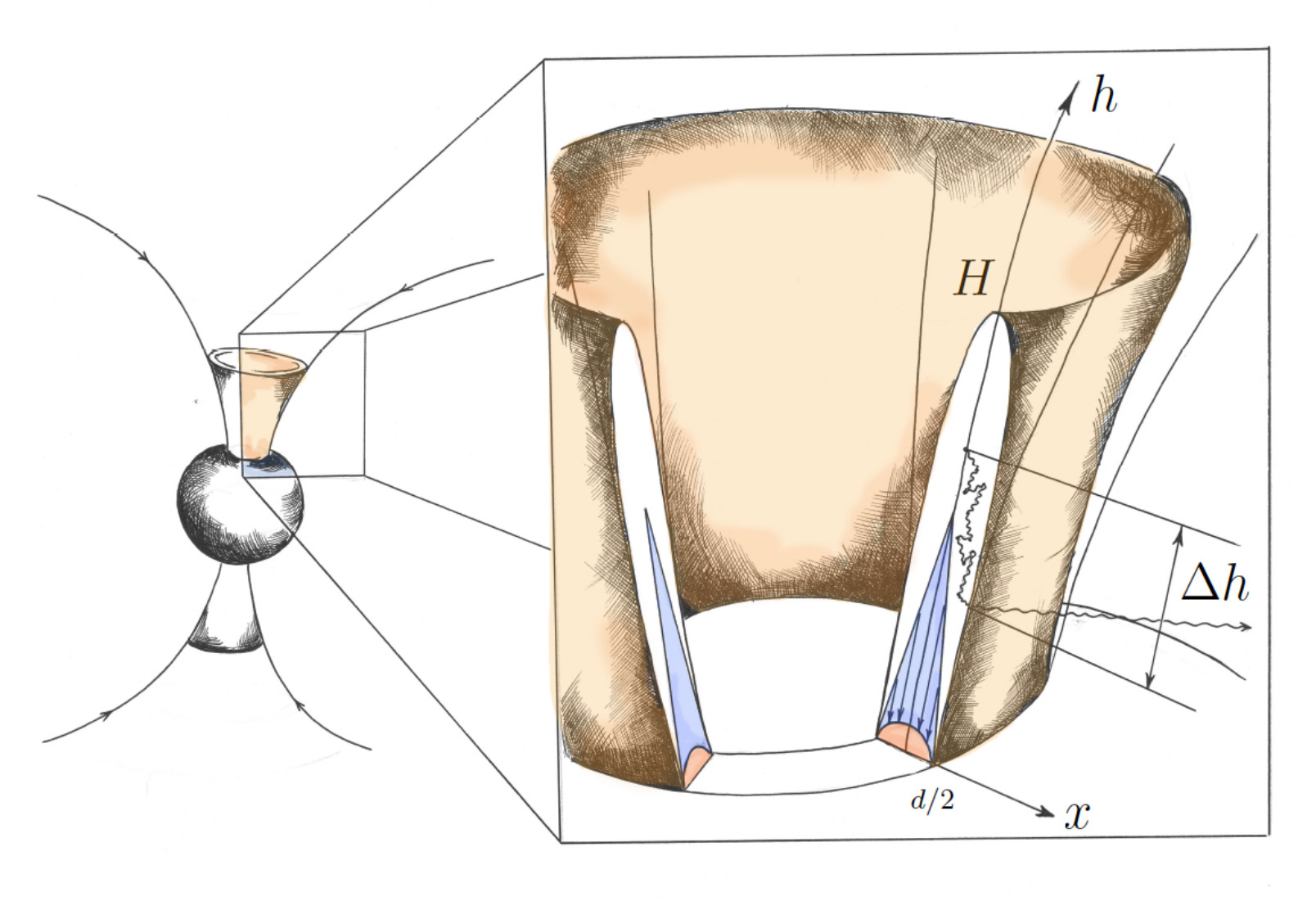 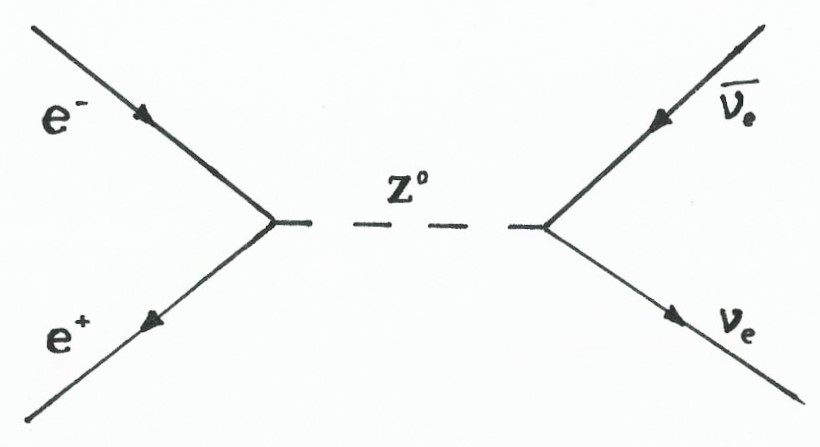 |
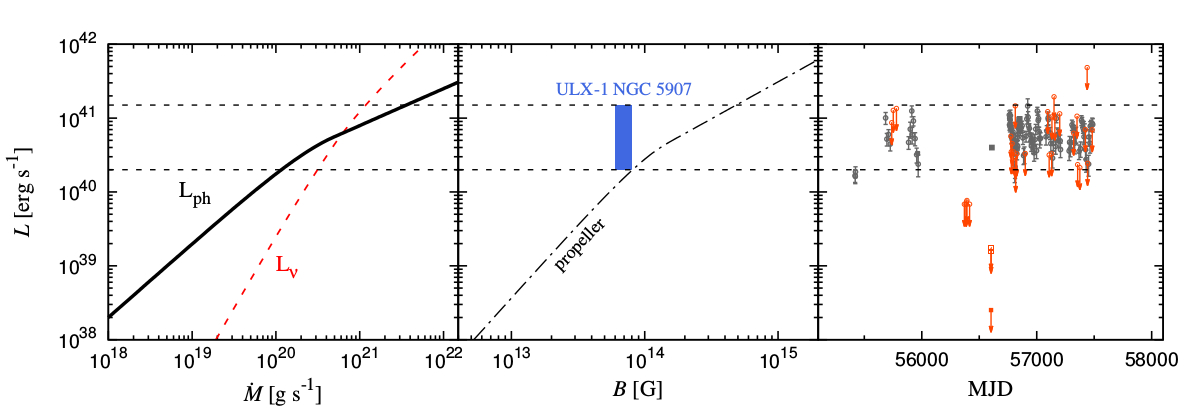
Paper on the propagating mass accretion rate fluctuations
December, 2017
|
We have published a paper with a detailed analysis of the process of propagation of mass accretion rate fluctuations in accretion disc under influence of viscous diffusion. The results of the paper are directly applicable to the analysis of aperiodic variability in X-ray binaries and active galactic nuclei. The mass accretion rate fluctuations originate from variability of viscosity, which arises at every radius and causes local fluctuations of the density. The fluctuations diffuse through the disc and result in local variability of the mass accretion rate, which modulates the X-ray flux from the inner disc in the case of black holes, or from the surface in the case of neutron stars. A key role in the theoretical explanation of fast variability belongs to the description of the diffusion process. The propagation and evolution of the fluctuations are described by the diffusion equation, which can be solved by the method of Green functions. We implement Green functions in order to accurately describe the propagation of fluctuations in the disc. For the first time, we consider both forward and backward propagation. In this paper, we show that (i) viscous diffusion efficiently suppress variability at time scales shorter than the viscous time, (ii) local fluctuations of viscosity affect the mass accretion rate variability both in the inner and the outer parts of accretion disc, (iii) propagating fluctuations give rise not only to hard time lags as previously shown, but also produce soft lags at high frequency similar to those routinely attributed to reprocessing, (iv) deviation from the linear rms-flux relation is predicted for the case of very large initial perturbations. [see the article] |
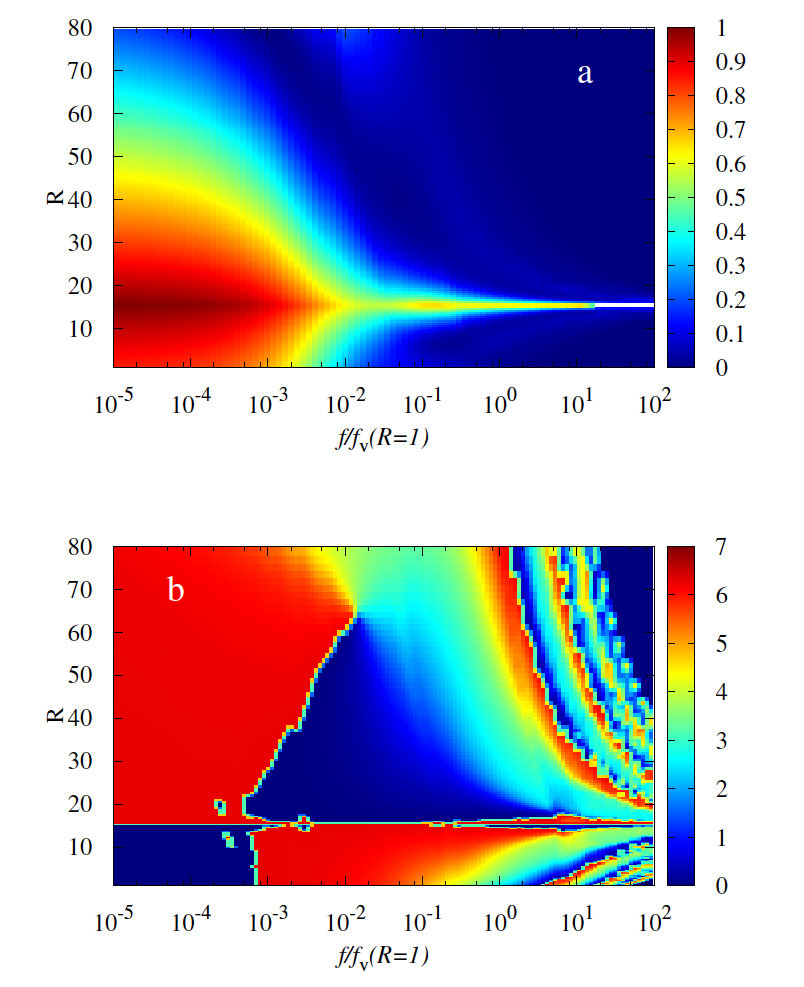
|
Radiation beaming in bright X-ray pulsars
December, 2017
 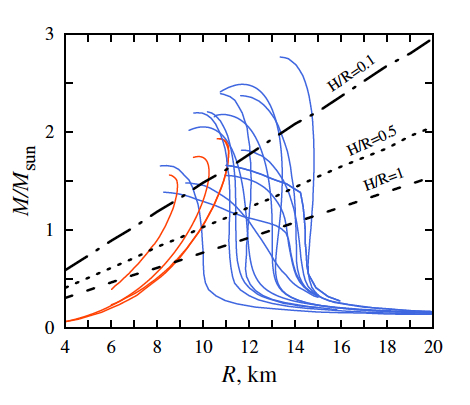
|
It is well known nowadays that the luminosity of accreting magnetized neutron stars can largely exceed the Eddington value due to appearance of accretion columns. It is likely that the height of the columns can be comparable to the neutron star radius. The columns produce the X-rays detected by the observer directly and illuminate the stellar surface, which reprocesses the X-rays and causes additional component of the observed flux. The geometry of the column and the illuminated part of the surface determine the radiation beaming. Curved space-time affects the angular flux distribution. We have constructed a simple model of the beam patterns formed by direct and reflected flux from the column taking into account the possibility of appearance of accretion columns, whose height is comparable to the neutron star radius. We argue that depending on the compactness of the star, the flux from the column can be either strongly amplified due to gravitational lensing, or significantly reduced due to column eclipse by the star. The eclipses of high accretion columns result in specific features in pulse profiles. Their detection can put constraints on the neutron star radius. We speculate that column eclipses are observed in X-ray pulsar V 0332+53, leading us to the conclusion of large neutron star radius in this system (~14-15 km). We point out that the beam pattern can be strongly affected by scattering in the accretion channel at high luminosity, which has to be taken into account in the models reproducing the pulse profiles. [see the article] |
Stable accretion from a cold disc in highly magnetized neutron stars
November, 2017
|
We proposed a model of accretion from the cold disc in the systems harbouring neutron stars with strong magnetic fields. The basic idea of the model is that in slowly rotating neutron stars the centrifugal barrier caused by the rotating magnetosphere is greatly suppressed in comparison to the fast rotating neutron stars, leading to a much lower threshold luminosity for the transition to the propeller regime. This allows such sources to reach mass-accretion rates that are so low that the temperature throughout the accretion disc becomes lower than the hydrogen recombination limit of ∼6500 K. The model has strong predictive power. Particularly, the transition to the accretion regime from a cold disc is expected to be observed in all XRPs with a certain combination of pulse period and magnetic field strength. Other manifestations of the cold disc accretion associated with a change in disc structure could be anticipated. A change of the inner disc radius can be expected to affect the spin evolution of the pulsar, aperiodic variability properties, pulse profiles, and the energy spectrum of the source. [see the article] |
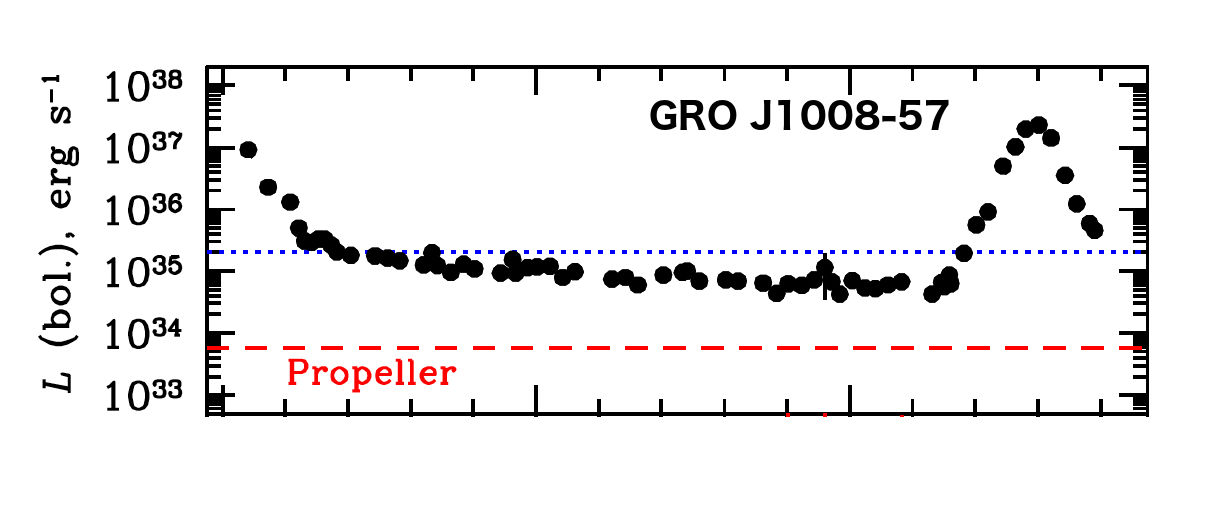 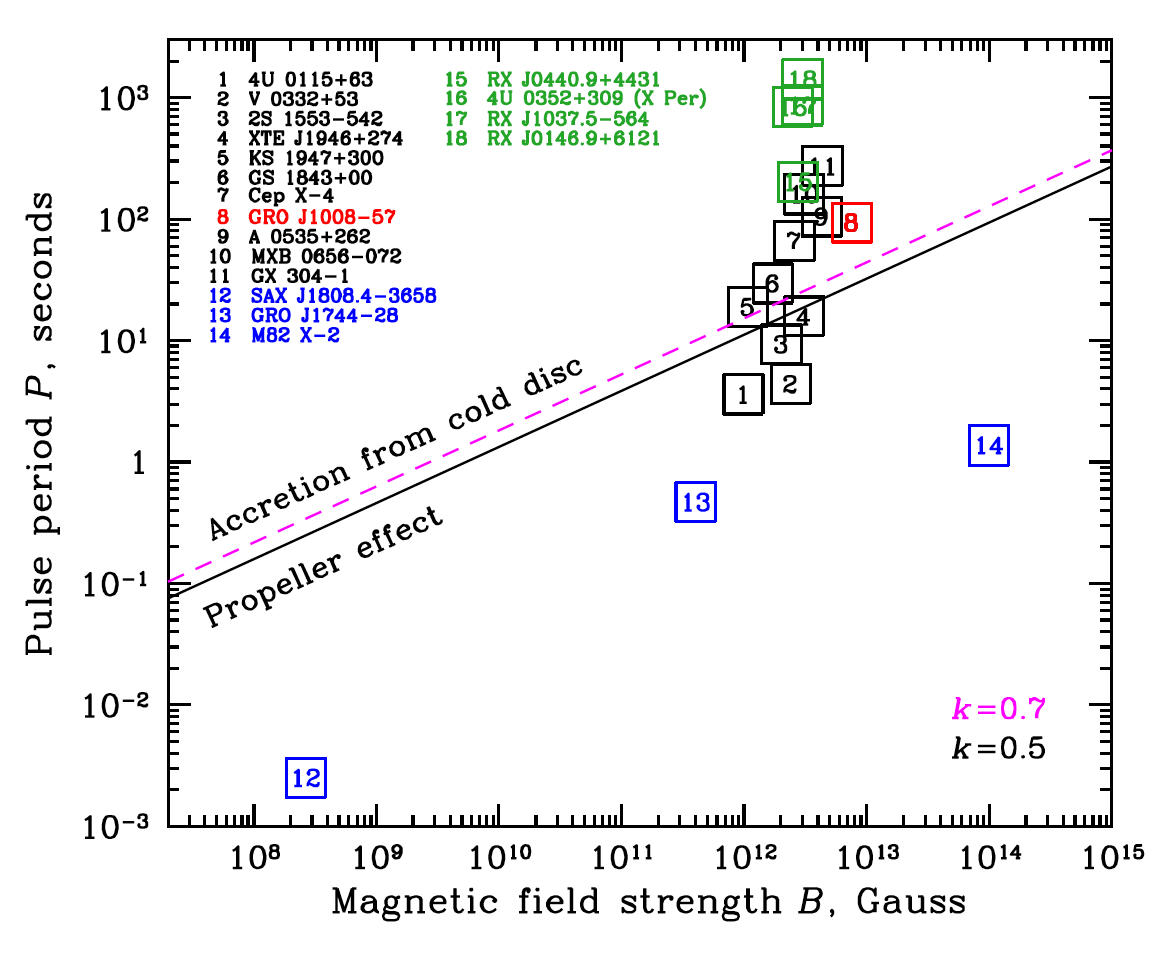
|
